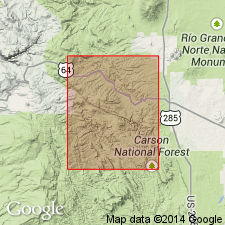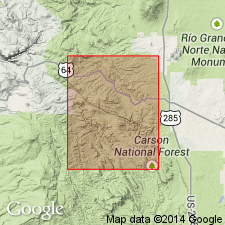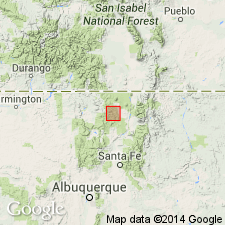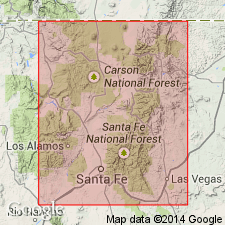
- Usage in publication:
-
- Big Rock conglomerate member
- Modifications:
-
- Original reference
- Dominant lithology:
-
- Conglomerate
- AAPG geologic province:
-
- Southern Rocky Mountain region
Summary:
Pg. 1, 20, 24-25, pl. 1. Big Rock conglomerate member of Kiawa Mountain formation. Consists of dark- to medium-gray, quartz-pebble conglomerate with intercalated slightly feldspathic quartzite. Most pebbles are light-gray quartz; a few are red and black quartz. Cross-bedding common, and current bedding commonly well defined by laminae of iron oxide as well as by layers of differing grain size. Pebbles mostly in the 1- to 5-inch range and are well- to poorly-sorted and highly rounded. Thickness 50 to 200 feet. Underlies [lower] quartzite member of Kiawa Mountain; overlies Ortega quartzite [restricted]. [Relation to Jawbone conglomerate member (new) of Kiawa Mountain not discussed.] Age is Precambrian.
Extends along its strike from NE/4 sec. 20, T. 27 N., R. 8 E., to Big Rock syncline, (0.2 mi northwest of Big Rock) and north of the Poso anticline; also in SE/4 SW/4 sec. 23, T. 27 N. R. 8 E., Las Tablas quadrangle, Rio Arriba Co., central northern NM.
[Big Rock located in sec. 23, T. 27 N., R. 8 E., Las Tablas quadrangle, Rio Arriba Co., Carson National Forest area, central northern NM (USGS GNIS database, USGS historical topographic map collection TopoView).]
Source: US geologic names lexicon (USGS Bull. 1200, p. 338); supplemental information from GNU records (USGS DDS-6; Denver GNULEX).

- Usage in publication:
-
- Big Rock Conglomerate Member*
- Modifications:
-
- Principal reference
- Adopted
- AAPG geologic province:
-
- Southern Rocky Mountain region
Summary:
Pg. A3, A21, A22. Big Rock Conglomerate Member of Kiawa Mountain Formation of Barker (1958). Rocks previously included in upper part of Just's (1937) Ortega Quartzite. Consists of interlayered gray quartzose conglomerate and pebbly quartzite. Clasts are quartz and jasper, generally 0.5 to 5 inches maximum dimension. Matrix is quartz (60 to 80 percent), microcline and muscovite, and accessory biotite, garnet, and hematite. Current-bedding and cross-stratification common. Is intricately folded; thickness estimated to be 100 to 200 feet. Overlies Ortega Quartzite (restricted). Partly covered by Tertiary conglomerate. Intruded by Precambrian rhyolite. Stratigraphic relation of Big Rock to lowest conglomerate in Burned Mountain quadrangle, the Jawbone Conglomerate Member of the Kiawa Mountain, is unknown. Age is Precambrian. (Big Rock Conglomerate Member of Kiawa Mountain Formation adopted by the USGS.)
Type locality: in SE/4 sec. 27, T. 27 N., R. 8 E., [about 1.5 mi southwest of Big Rock], Las Tablas 7.5-min quadrangle, Rio Arriba Co., [Carson National Forest area], central northern NM. Named from Big Rock, in sec. 23, T. 27 N., R. 8 E., Las Tablas 7.5-min quadrangle, [Carson National Forest], Rio Arriba Co., central northern NM.
[Type locality corrected to NW/4 sec. 27. See Wobus (1985) entry.]
Source: Publication.

- Usage in publication:
-
- Big Rock Conglomerate Member*
- Modifications:
-
- Principal reference
- Revised
- AAPG geologic province:
-
- Southern Rocky Mountain region
Summary:
Pg. 4, 6 (geol. map), 9, 10-11 (cross sections), 15, 16 (table 1). Big Rock Conglomerate Member of Burned Mountain Metarhyolite. Is a thin, discontinuous layer of quartz-pebble conglomerate 50 to 200 feet (15 to 60 m) thick that crops out on La Jarita Mesa. Previously assigned to †Kiawa Mountain Formation (abandoned). Consists of conglomeratic layers and lenses that are wholly within the metavolcanic-metasedimentary section, not at the base of the Kiawa Mountain Formation as defined by Barker (1970). These conglomerate beds are locally highly deformed but contain recognizable cobbles and pebbles of metarhyolite; they were probably deposited in a braided alluvial environment. This distinctive conglomerate on La Jarita Mesa forms important marker beds (former stream channel deposits) in an otherwise monotonous terrane of muscovitized felsic metavolcanic rocks. Age is Early Proterozoic.
Principal reference section (=type locality of Barker corrected): on northwest-trending ridge in NW/4 sec. 27, T. 27 N., R. 8 E., southeast of 8,715 ft elev., about 1.2 mi (2 km) southwest of Big Rock, Las Tablas 7.5-min quadrangle, Rio Arriba Co., [Mesa de la Jarita, Carson National Forest area], central northern NM. (Barker's type locality mislocated; there is no conglomerate in SE/4 sec. 27.)
Source: Publication.

- Usage in publication:
-
- Big Rock Formation
- Modifications:
-
- Principal reference
- Revised
- Redescribed
- Dominant lithology:
-
- Conglomerate
- Quartzite
- AAPG geologic province:
-
- Southern Rocky Mountain region
Summary:
Pg. 46 (table 1), 49. Big Rock Formation of Vadito Group. Recognized in the Tusas Mountains of central northern New Mexico. Previously called Big Rock Conglomerate Member of Kiawa Mountain Formation (citing Barker, 1958). Consists of an upper member, chiefly micaceous and feldspathic quartzite, and a lower member, chiefly [meta]conglomerate with minor interlayered micaceous quartzite. Metaconglomerate layers are characterized by elongate cobbles, 1 to 20 cm in diameter, of vein quartz, quartzite, schist, and metarhyolite in a matrix of quartz-muscovite schist or quartzite. Locally, a thin impure quartzite is present below the main metaconglomerate horizon. Is considered roughly = Marquenas Formation of Vadito Group in the Picuris Mountains. Metaconglomerate layers are lithologically similar; most noteworthy difference is the large volume of impure quartzite interlayered with metaconglomerate in the Marquenas. Average thickness of formation about 200 feet (60 m). Shown on table 1 below Ortega Formation of Hondo Group and above Burned Mountain Formation of Vadito Group. Age is considered Early Proterozoic, ca. 1,700 Ma.
Type section: Mesa de la Jarita, in secs. 22 and 29 [27?], T. 27 N., R. 8 E., Las Tablas 7.5-min quadrangle, Rio Arriba Co., [Carson National Forest area], central northern NM. [Ortega Quartzite mapped in sec. 29 (see Aby et al, 2010, New Mexico Bur. Geol. Min. Res., Prelim. geol. Las Tablas quad., OF-GM 200, scale 1:24,000).]
Source: Publication.
For more information, please contact Nancy Stamm, Geologic Names Committee Secretary.
Asterisk (*) indicates published by U.S. Geological Survey authors.
"No current usage" (†) implies that a name has been abandoned or has fallen into disuse. Former usage and, if known, replacement name given in parentheses ( ).
Slash (/) indicates name conflicts with nomenclatural guidelines (CSN, 1933; ACSN, 1961, 1970; NACSN, 1983, 2005, 2021). May be explained within brackets ([ ]).

